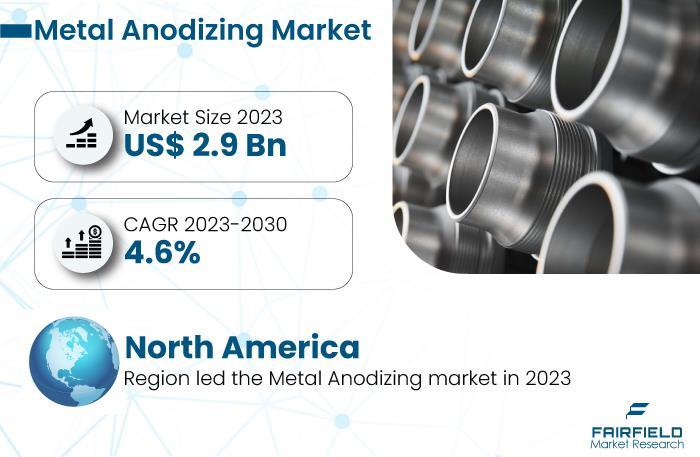Global market for metal anodizing is poised for substantial growth, with projections indicating a leap from US$2.9 billion in 2023 to a staggering US$4.0 billion by 2030. This forecasted expansion, with a Compound Annual Growth Rate (CAGR) of 4.6% between 2023 and 2030, underscores the increasing significance of metal anodizing across diverse industries worldwide.

For More Industry Insights Read:
https://www.fairfieldmarketresearch.com/report/metal-anodizing-market
Trend Insights Driving Market Growth
1. Rise in Medical Device Applications: The burgeoning demand for metal anodizing is notably fueled by its growing applications in the medical device sector. With biocompatibility being a paramount concern, anodized metals stand out for their suitability in surgical instruments, implants, and various medical applications, contributing to enhanced patient safety and product reliability.
2. Integration with 3D Printing: Another significant trend propelling the market forward is the increasing integration of anodized metals in 3D printing. Preserving electrical and thermal conductivity, anodized metals are finding utility in critical applications such as electronic components, thereby expanding the scope of metal anodizing across innovative technological landscapes.
3. Quality Control Challenges: However, challenges persist, particularly in maintaining consistent quality in large-scale production. Variations in coating performance, color, and
thickness pose hurdles, necessitating stringent quality control measures to ensure product acceptance and reliability.
Key Growth Determinants
1. Automotive Industry Demand: The automotive sector's emphasis on lightweight design for pollution reduction and enhanced fuel efficiency is driving significant demand for anodized aluminum. Offering improved strength and corrosion resistance, anodized aluminum finds applications in various automotive components, contributing to prolonged longevity and aesthetic appeal.
2. Aerospace and Defence Applications: Anodized coatings play a pivotal role in aerospace and defence applications, offering exceptional corrosion protection and enhanced durability against extreme climatic conditions. With increased investments in aeronautical technologies, the aerospace sector continues to be a significant driver for metal anodizing market growth.
3. Expansion in Construction and Architecture: The construction and architecture sectors are witnessing a surge in the adoption of anodized coatings for their robustness and corrosion resistance properties. From curtain walls to cladding, anodized aluminum finds extensive use in external building applications, catering to the demands of infrastructure development worldwide.
Major Growth Barriers
1. High Initial Capital Investments: Setting up a metal anodizing facility entails substantial capital investments in specialized machinery and infrastructure, posing a barrier to entry for new market players and potentially hindering industrial innovation.
2. Complexity in Large Part Anodizing: Achieving uniform coating thickness on large items presents challenges, necessitating complex rack and fixture designs and efficient equipment operation to ensure consistent quality standards.
Key Trends and Opportunities
1. Embrace of Sustainable Processes: The industry is witnessing a shift towards environmentally friendly anodizing techniques, employing substitutes and chemicals that reduce the environmental footprint and emissions, thus fostering sustainability and ecofriendliness.
2. Advancements in Nanotechnology: Nanotechnology is paving the way for enhanced corrosion resistance and mechanical properties of anodized coatings, offering improved durability and performance across diverse applications.
3. Integration of Industry 4.0: Automation and digitalization are revolutionizing the metal anodizing process, enabling optimized production settings, predictive maintenance, and consistent quality control, thereby enhancing efficiency and operational excellence.
Regional Frontrunners
1. North America: Dominating the market, North America benefits from robust demand in the aerospace, defence, and automotive sectors, coupled with ongoing investments in renewable energy sources, driving the adoption of anodized materials.
2. Asia Pacific: Emerging as the fastest-growing region, Asia Pacific capitalizes on its burgeoning industrialization, urbanization, and infrastructure development, fueling demand across diverse end-use industries and propelling market expansion.
Competitive Landscape Analysis
In the global metal anodizing space, a handful of leading companies are spearheading innovation and market expansion, with initiatives focused on product development and enhanced distribution networks. Notable players include Lintec, Aalberts Surface Treatment, Talon Innovations Corporation, and others.
